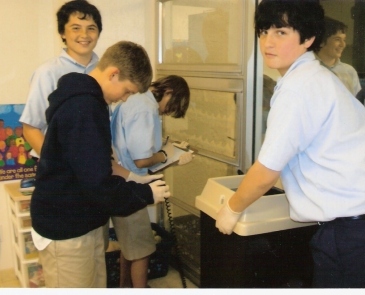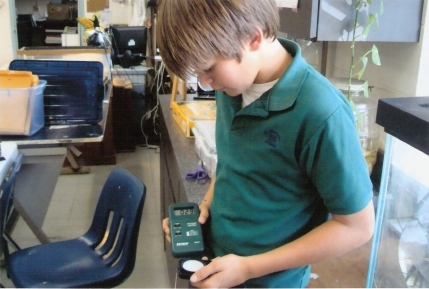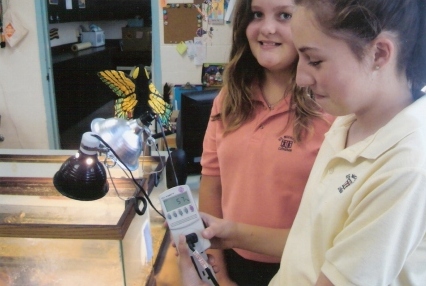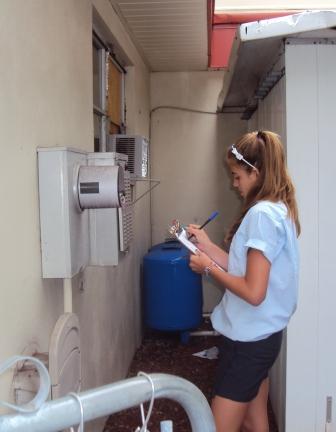St. Michael Lutheran School (SMLS) is a K-8 parochial school on Florida’s Gulf Coast. Its 380 students come from throughout Lee County.
 SMLS has been a Florida PLT School for more than a decade. Through this program, at least half the teaching faculty has attended a PLT workshop, PLT activities are incorporated into the curriculum or there is a designated PLT Week, and the school has a PLT Coordinator.
SMLS has been a Florida PLT School for more than a decade. Through this program, at least half the teaching faculty has attended a PLT workshop, PLT activities are incorporated into the curriculum or there is a designated PLT Week, and the school has a PLT Coordinator.
“PLT gives us at St. Michael an opportunity to live out our convictions in word and deed,” said principal Robert Ziegler. “Caring for the environment is a win-win scenario that teaches us to be self-disciplined and care for things outside ourselves.”
Becoming a PLT GreenSchool was a team effort, as middle school science teacher Katie Schlotterbeck recalled, involving students, teachers, staff, and the community. For example, the school’s director of finance and bookkeeper helped students gather and analyze data, as did the head of maintenance. The cafeteria manager supported recycling efforts, and electricians in the community helped install sensors to reduce electricity usage.
Knowledge led to action. ““I taught a lesson on biodegradability in October to all of my middle school classes and afterwards the amount of water bottles and soda cans that were recycled at lunch increased,” Schlotterbeck noted. “We all need reminders.”
In addition, the action extended from school to home. As seventh-grader Alex Quattrone said, “The recycling things that we have learned at school, I have brought home and taught my family.”
Another student, McKenzie Campagnolo, added, “GreenSchools has helped me learn what I can do not only to help my school, but to help my home and community. It was fun to do this with my friends and know that I was making a difference.”
Energy Investigation
 Through their investigation, 6th graders recognized the difference in energy usage between six rooms that had motion-activated light sensors and the rest of the campus. Their action project: installing more light sensors throughout the school. A local contractor partnered with the students to help them figure out which sensors to use and how to calculate the projected savings. Another electrician volunteered his time to install 52 sensors. The students determined that electricity bills did not rise from 2007 to 2011 (latest figures available), even though electricity rates had significantly increased.
Through their investigation, 6th graders recognized the difference in energy usage between six rooms that had motion-activated light sensors and the rest of the campus. Their action project: installing more light sensors throughout the school. A local contractor partnered with the students to help them figure out which sensors to use and how to calculate the projected savings. Another electrician volunteered his time to install 52 sensors. The students determined that electricity bills did not rise from 2007 to 2011 (latest figures available), even though electricity rates had significantly increased.
 The project was integrated into school curricula through lesson plans and activities at all levels. A school poster contest, skits, and other student-led activities also extended the learning throughout the school.
The project was integrated into school curricula through lesson plans and activities at all levels. A school poster contest, skits, and other student-led activities also extended the learning throughout the school.
Waste and Recycling Investigation
Students reflected on the amount of waste produced by the school and considered how much of it could be recycled. They created a Recycling Club and instituted recycling in classrooms and the cafeteria. Students monitor and empty the containers, and help fellow students to establish a “recycling routine” at lunchtime.
The investigation also resulted in other changes. Removing small waste cans from classrooms reduced use of plastic liners by 80 percent. Printing on both sides of the page and relying more on email than printed communication reduced paper usage.
“Coming to Saint Michael in the 7th grade, I learned just how green this school is,” said student Danielle Cambareri. “At SMLS, we don’t just recycle paper, we recycle bottles and cans and all the classrooms have motion sensors which save on electricity.”
 Water Investigation
Water Investigation
The students discovered that 7% of the faucets and 5% of the toilets leaked. They advocated for repair and replacement of broken toilets with low-flow models. The water bill has remained constant since 2007, despite a local increase in the cost of water.
Water education is taught in all classes, with a major emphasis in grades 3, 4, and 6.
School Site Investigation
The school has several gardens: a butterfly garden, as well as those planted with vegetables, flowers, and fruit. Students added a hydroponics garden that uses rainwater caught in barrels. A small outdoor pond houses turtles that have outgrown classroom aquariums. Students attending the school’s summer science camp mapped, labeled, and tagged all the trees on campus.
Different grade levels now regularly use the outdoor space to enhance learning—from a courtyard area, to the gardens, to the soccer field for science activities.
Environmental Quality Investigation
Students have focused on indoor and outdoor air quality. They help in monthly monitoring and maintenance of the ventilation system, which includes changing classroom air-conditioning filters.
Three no-idling zones were set up on the campus. Students measured 800 pounds of carbon dioxide produced before no-idling signs were installed, compared to 425 pounds afterwards.


